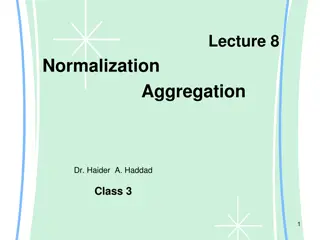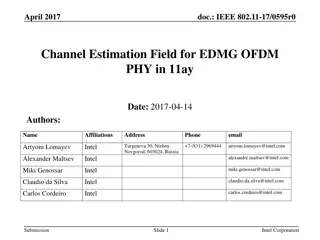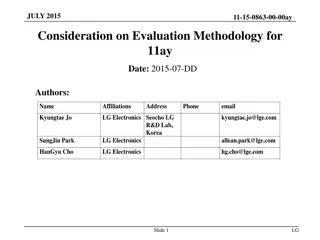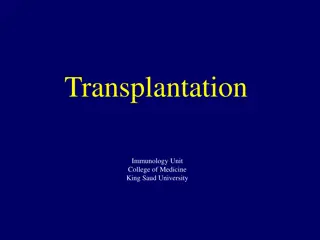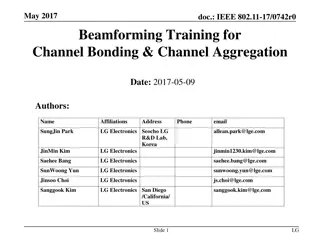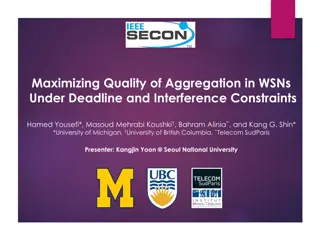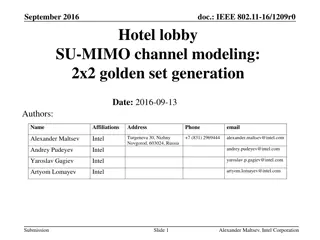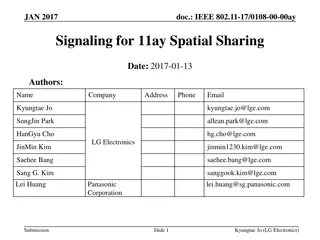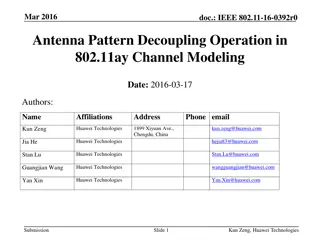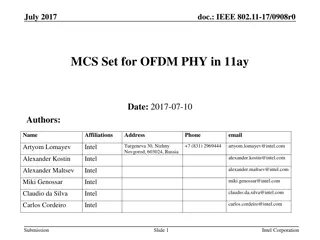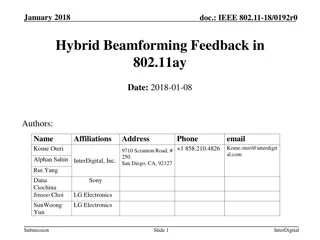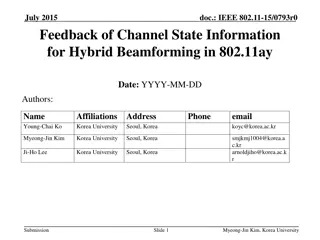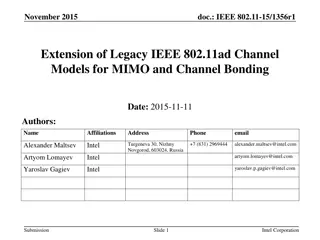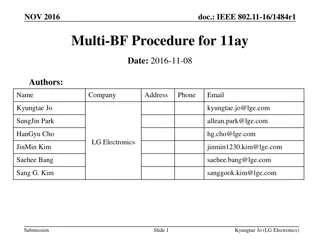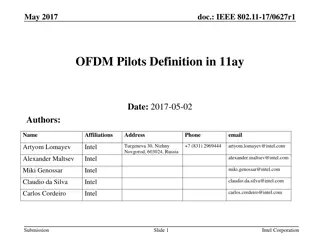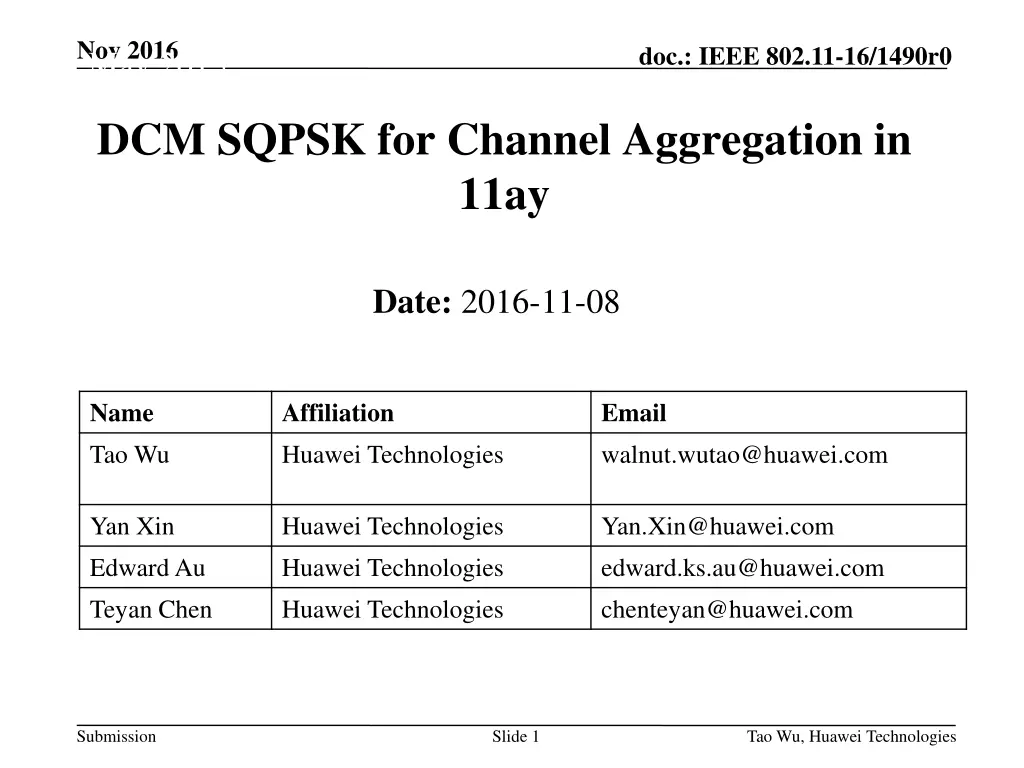
Performance Analysis of DCM SQPSK for Channel Aggregation in IEEE 802.11ay
Explore the performance benefits of utilizing Dual Carrier Modulation (DCM) SQPSK for channel aggregation in IEEE 802.11ay standard. The study compares DCM SQPSK with other modulation methods over single and aggregated channels, showcasing significant performance gains. Recommendations are made for optimal utilization of DCM SQPSK for two-channel aggregation in single carrier transmission mode.
Download Presentation

Please find below an Image/Link to download the presentation.
The content on the website is provided AS IS for your information and personal use only. It may not be sold, licensed, or shared on other websites without obtaining consent from the author. If you encounter any issues during the download, it is possible that the publisher has removed the file from their server.
You are allowed to download the files provided on this website for personal or commercial use, subject to the condition that they are used lawfully. All files are the property of their respective owners.
The content on the website is provided AS IS for your information and personal use only. It may not be sold, licensed, or shared on other websites without obtaining consent from the author.
E N D
Presentation Transcript
Nov 2016 May 2015 doc.: IEEE 802.11-16/1490r0 DCM SQPSK for Channel Aggregation in 11ay Date: 2016-11-08 Name Tao Wu Affiliation Huawei Technologies Email walnut.wutao@huawei.com Yan Xin Edward Au Teyan Chen Huawei Technologies Huawei Technologies Huawei Technologies Yan.Xin@huawei.com edward.ks.au@huawei.com chenteyan@huawei.com Submission Slide 1 Tao Wu, Huawei Technologies
Nov 2016 doc.: IEEE 802.11-16/1490r0 Introduction In [1], the performance of Dual Carrier Modulations (DCMs) and regular modulation is compared. DCM is suggested to be used in 2x2 SU MIMO. This presentation compares the SC mode performance of DCM SQPSK we proposed for 11ay with other methods of the same data rate transmitted over two aggregated channels or over a single channel. The considered transmissions include: BPSK over two aggregated channels (CA BPSK); BPSK with an interleaver over two aggregated channels (CA BPSK interleaver); DCM SQPSK over two aggregated channels (CA DCM SQPSK); QPSK over one channel (One channel); For DCM SQPSK over two aggregated channels, two receiver algorithms are considered: Combining the received signals from two aggregated channels in the time domain; Combining the received signals from two aggregated channels in the frequency domain; Based on our simulation evaluation, DCM SQPSK over two aggregated channels outperforms the other alternative methods. It can yield up to 2.1 dB and 2.7 dB performance gains compared to the BPSK with an interleaver over two aggregated channels and the QPSK over one channel, respectively. We suggest that the DCM SQPSK is used for two-channel aggregation in the single carrier transmission mode. 11-16-0631-00-00ay-performance-comparison-of-dual-carrier-and- regular-modulations-for-su-mimo-in-11ay Submission Slide 2 Tao Wu, Huawei Technologies
Nov 2016 doc.: IEEE 802.11-16/1490r0 Simulation Assumptions Single Carrier mode: No backoff; BPSK, QPSK and DCM SQPSK modulations; Interleaver which interleaves the coded bits from two encoder; Two-channel aggregation and one channel; 11ad CR NLOS channel; 11ad phase noise model; 11ad non linear PA model; Non-Ideal channel estimation; L-MMSE Equalization; 11ad LDPC code; Submission Slide 3 Tao Wu, Huawei Technologies
Nov 2016 doc.: IEEE 802.11-16/1490r0 Channel Aggregation One Channel Two Channel Aggregation In our simulation, the transmit power is assumed to be the same for both the signals transmitted over one channel and two aggregated channels. For the case of two-channel aggregation, the transmitted signals over each channel are encoded and modulated independently. Submission Slide 4 Tao Wu, Huawei Technologies
Nov 2016 doc.: IEEE 802.11-16/1490r0 BPSK with an Interleaver for channel aggregation After interleaving, the transmitted signals over each channel include coded bits from both encoders: The outputs of the two encoders are transmitted alternately on each channel; Submission Slide 5 Tao Wu, Huawei Technologies
Nov 2016 doc.: IEEE 802.11-16/1490r0 DCM SQPSK Submission Slide 6 Tao Wu, Huawei Technologies
Nov 2016 doc.: IEEE 802.11-16/1490r0 Receiver Algorithm: combining the signals in time/frequency domain Combining signals in frequency domain can yield more than 0.4dB gain over combining signals in time domain. Submission Slide 7 Tao Wu, Huawei Technologies
Nov 2016 doc.: IEEE 802.11-16/1490r0 PAPR of DCM SQPSK PAPR>PRPR0 The simulation results above show that: the PAPR characteristics of DCM SQPSK signals in channel aggregation (CA DCM SQPSK) is comparable to that of BPSK in channel aggregation (CA BPSK). Submission Slide 8 Tao Wu, Huawei Technologies
Nov 2016 doc.: IEEE 802.11-16/1490r0 Simulated FER of DCM SQPSK Submission Slide 9 Tao Wu, Huawei Technologies
Nov 2016 doc.: IEEE 802.11-16/1490r0 Performance Comparison SNR for FER =1% Throughput gain for DCM SQPSK FER = 1% MCS (in each aggregate d channel) CA BPSK CA BPSK Interleav er CA DCM SQPSK Combining in time domain 1.9 3.0 4.6 5.6 CA DCM SQPSK Combining in freq domain 1.5 2.6 3.9 4.8 QPSK (one channel) Data Rate (Mbps) 2 3 4 5 2.6 4.7 6.3 7.6 2.6 4.0 5.8 6.9 2.5 4.4 6.0 7.5 762.3 952.9 1143.5 1238.7 Compared with the method of CA BPSK Interleaver , DCM SQPSK can yield performance gains in a range of 1.1 dB to 2.1 dB according to different MCS configurations. Compared with the different receiver algorithm for CA DCM SQPSK, combing signals in frequency domain can yield more than 0.4 dB gain over combing signals in time domain . 10 Submission Slide 10 Tao Wu, Huawei Technologies
Nov 2016 doc.: IEEE 802.11-16/1490r0 Summary In this contribution, we compared the performance of the DCM SQPSK, the BPSK with interleaver across two channels and the QPSK in one channel in single carrier transmission. Based on our simulation, DCM SQPSK over two aggregated channels can yield up to 2.1 dB gain compared to BPSK signals interleaved over two aggregated channels and 2.7 dB gain compared to QPSK over one channel. We suggest to adopt the DCM SQPSK in two-channel aggregation in the single carrier mode of 11ay. Submission Slide 11 Tao Wu, Huawei Technologies
Nov 2016 doc.: IEEE 802.11-16/1490r0 Straw Poll/Motion Do you agree to add the following text to the SFD ? In the Single Carrier mode in 11ay, DCM SQPSK signals transmitted over two aggregated channels presented in page 6 may be supported. Yes No Abstain Submission Slide 12 Tao Wu, Huawei Technologies
Nov 2016 doc.: IEEE 802.11-16/1490r0 Appendix: Introduction of Receiver Algorithm Submission Slide 13 Tao Wu, Huawei Technologies
Nov 2016 doc.: IEEE 802.11-16/1490r0 Appendix 1: Combining the signals in time domain Submission Slide 14 Tao Wu, Huawei Technologies
Nov 2016 doc.: IEEE 802.11-16/1490r0 Appendix 1: Combining the signals in time domain Submission Slide 15 Tao Wu, Huawei Technologies
Nov 2016 doc.: IEEE 802.11-16/1490r0 Appendix 2: Combining the signals in frequency domain Submission Slide 16 Tao Wu, Huawei Technologies
Nov 2016 Appendix 2: Combining the signals in frequency domain doc.: IEEE 802.11-16/1490r0 Submission Slide 17 Tao Wu, Huawei Technologies
Nov 2016 Appendix 2: Combining the signals in frequency domain doc.: IEEE 802.11-16/1490r0 Submission Slide 18 Tao Wu, Huawei Technologies


